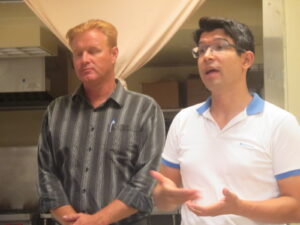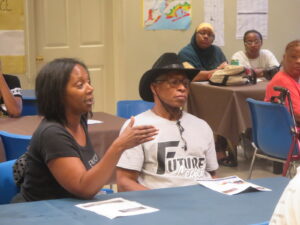Amid construction on Red Hook’s public housing developments, questions about asbestos have been circulating throughout the neighborhood. Resulting from an influx of calls, residents succeeded in grabbing the attention of their elected officials, as New York City Councilman Carlos Menchaca called a meeting to update locals on this process.

This evening, Monday July 28, several officials from NYCHA and their affiliated construction management companies joined Menchaca at the Miccio Community Center to give a brief synopsis of their work, ensure safety, and address concerns. With a casually dressed Menchaca taking on the role of meeting moderator, the officials took the lead in explaining their work in the area.
Brian Honan, director of NYCHA State and City Legislative Affairs, began first by hailing the positive direction of the construction. As many residents already know, Honan explained that Red Hook had not been receiving its fair share of state funding for a long time. Because of this he lauded the work as a good sign, proving that Red Hook is a vital city neighborhood receiving the support it deserves. In acknowledgement of the storm that has left its mark on so many Red Hook residents, Honan emphasized the importance of the work as part resiliency efforts in the post-Sandy neighborhood.
Honan also mentioned the city’s commitment to Red Hook. He described a recent walking tour of the neighborhood with representatives including Menchaca, extolling it as an “unprecedented dialogue between NYCHA and elected officials.”
Moving onto the practical issues of construction, the director briefly assured the room that all work was being done under state regulation. That said, he handed off to NYCHA’s construction management team.
Steven McGrath of TDX Construction Corp. took over next. His company is contracted by NYCHA throughout the city as a third party construction management group. As a result, he oversees the construction on Red Hook’s houses on a day-to-day basis.
McGrath wasted no time in explaining the reason for the sudden work; the Department of Buildings requires that public housing facades be inspected and reported, and Red Hook’s houses needed to correct issues with exterior brickwork. Therefore, construction is relegated only to exterior work and roof repair.
That said, McGrath began to answer the main question on everyone’s minds: asbestos. Asbestos has been in brickwork and housing construction since the 70s, offering insulation and fire retardation. Products containing the substance were only outlawed in the 90s, so many buildings in Red Hook do contain it today.
Dangerous when airborne
Asbestos, McGrath assured, is only dangerous when airborne, and poses no threat to health and safety when sealed. However, the use of certain machinery in construction work releases particles into the air. Because of the danger that this may pose, NYCHA and the EPA have strict guidelines for the removal of this material.
Workers are required to put the products in containment units, seal them in plastic, and ship them away from the area each day. They are also required to monitor the quality of the air. McGrath even affirmed that all substances with unknown levels of the product are treated with caution as ‘ACM’ (asbestos-containing material).
Having said their piece, the construction representatives opened the floor to questions under the direction of the councilman.
Some of the first issues to arise regarded questions about construction oversight and concerns about communication. McGrath stated that several companies were overseeing the physical work, and encouraged tenants to speak to him or the superintendents with questions and problems.
Several audience members criticized the lack of initial communication on the city’s part, but also offered a number of means of improving it. Suggestions included a door-to-door policy for tenants who would be affected by the work, more flyers and posters in each building, and the selection of a neighborhood liaison to facilitate the spread of information.
Scaffolding
Scaffolding was also a hot topic for several reasons. At first, the question was simply why it took so long for scaffolding to come down after work had been completed. Brian Honon stepped in to offer an answer, explaining the fact that work must be reviewed by the Department of Buildings before the project can be officially completed and the structures can come down.
The workers occupying the scaffolding were also brought to attention; one resident found workers waking her up with talk of breakfast, staring into her home, and even watching her in bathroom on multiple occasions. While McGrath promised to investigate the matter and offered his apologies, she lightened the mood with a request to “tell them that Ramadan is over, and they can bring me breakfast now if they’re looking through my window.”
The night soon turned to a forum for more personal grievances, with representatives offering all the support they could. For every complaint about fencing off trash cans, the disturbing noises of construction, reported leaks roof leaks, and the entrance of dust into homes, NYCHA and TDX took down names and addresses with the promise to look into their troubles.
While the asbestos point reemerged at several points throughout the meeting, McGrath reiterated his main points: asbestos is not harmful while it is sealed and, since work is only being done on the exteriors of the houses, all worries and questions about interior asbestos should go through the usual channel of building management.
The meeting ended in frustration for some, and relief for many others. Some residents remained frustrated by the lack of communication preceding the meeting and some were still bitter about the inconveniences that the rebuilding was causing them. Still, fears about airborne asbestos were mostly assuaged, and the meeting did open the door for further communication and cooperation between NYCHA and its residents.
As Councilman Menchaca concluded, “This is the beginning of a lot more.”








